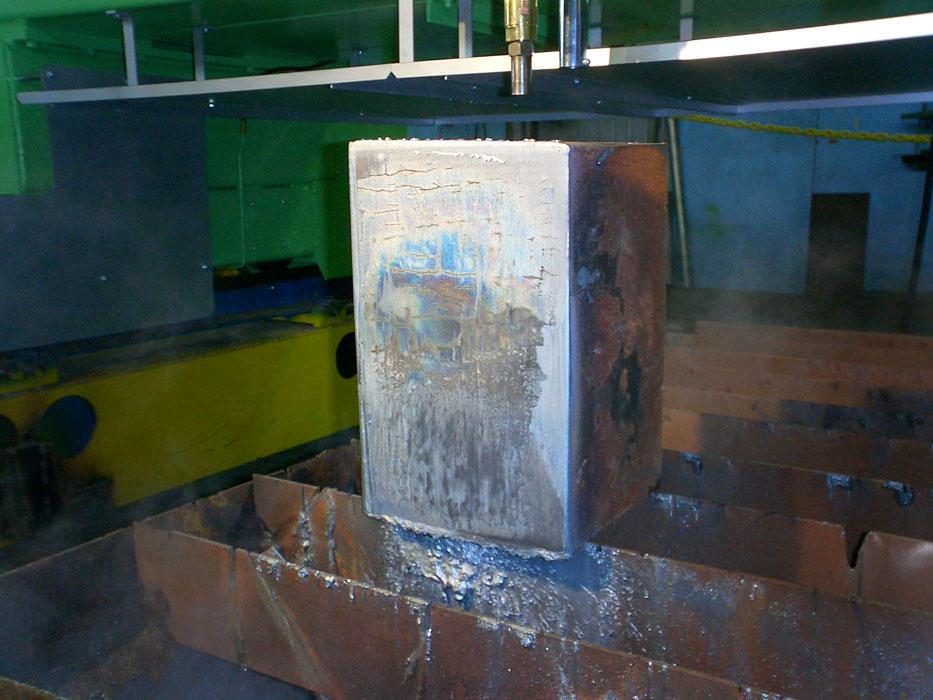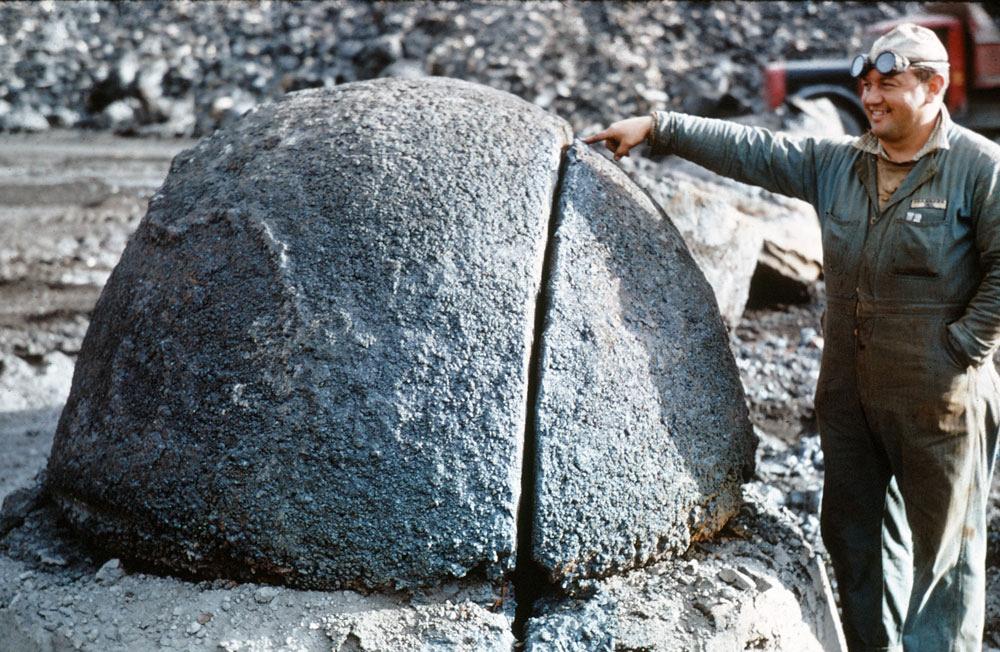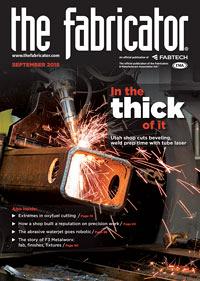Marketing and Export Manager
- FMA
- The Fabricator
- FABTECH
- Canadian Metalworking
Categories
- Additive Manufacturing
- Aluminum Welding
- Arc Welding
- Assembly and Joining
- Automation and Robotics
- Bending and Forming
- Consumables
- Cutting and Weld Prep
- Electric Vehicles
- En Español
- Finishing
- Hydroforming
- Laser Cutting
- Laser Welding
- Machining
- Manufacturing Software
- Materials Handling
- Metals/Materials
- Oxyfuel Cutting
- Plasma Cutting
- Power Tools
- Punching and Other Holemaking
- Roll Forming
- Safety
- Sawing
- Shearing
- Shop Management
- Testing and Measuring
- Tube and Pipe Fabrication
- Tube and Pipe Production
- Waterjet Cutting
Industry Directory
Webcasts
Podcasts
FAB 40
Advertise
Subscribe
Account Login
Search
Oxyfuel cutting very, very thick plate
Oxyfuel cutting remains the process of choice for extreme material thicknesses
- By Ron Krasnek and Tim Joslin
- August 27, 2018
- Article
- Cutting and Weld Prep
At a handful of industrial facilities on this planet, you’ll see a long flame cutting through a mountain of steel 10 feet deep. It looks volcanic, primordial, perhaps other-worldly. Making it happen is one of metal fabrication’s oldest technologies: oxyfuel cutting.
Very thick plate is oxyfuel cutting’s wheelhouse, and few if any cutting applications in the world are thicker than 10 ft. These industrial applications are part of scrapping operations, and the kerfs the flame produces aren’t pretty. But the application does show how powerful the oxyfuel flame—or, more precisely, the exothermic reaction the oxyfuel flame causes in carbon steel—can be in some extreme material thicknesses.
As the preheat fuel and oxygen mix and heat the workpiece to kindling temperature, the oxygen reacts with the iron in the material to help carry cutting energy through inches, and sometimes feet, of material thickness. The central oxygen jet takes over and cutting commences. In heavy plate cutting, the exothermic reaction, between the oxygen jet and iron in the material, really is what performs the cutting action.
Say a job comes up that requires you to cut material from 8 all the way up to 12 inches thick. What questions do you need to ask? You don’t need to ask “Can oxyfuel cut this?” It can.
Instead, your questions should first center on optimal safety, then on efficiency and the required quality. A properly designed oxyfuel cutting system should provide all three.
What’s the Best Cutting Process?
For material 3 in. and thicker, the answer is usually pretty straightforward. Typical laser cutting operations handle material up to about 1 to 1.25 in. thick. Plasma cutting’s upper limit is between 2 and 3 in.
For extreme thicknesses of steel plate—4, 6, 8, and even 10 in.—oxyfuel cutting is truly at home. Its vertical blue flame slices through to create a perpendicular edge. The tip size, kerf width, and (hence) gas usage rise with thicker material. But with correct speed and jet oxygen settings, as well as the proper tip and machine setup, you should see no washing out around corners.
Yes, an abrasive waterjet can cut plate that’s 8 in. thick. Doing so may make sense for certain applications, especially if material altered by a cut’s heat-affected zone would be detrimental. And sometimes waterjet cutting, a precision process, can eliminate secondary grinding or milling. But when you reach extreme material thicknesses—say, 8 in. and above—waterjet creeps extraordinarily slowly along the kerf. An oxyfuel flame might cut at only 8 in. per minute (IPM), but a waterjet might cut such extreme material at 0.1 IPM or even slower. There are exceptions, but for the most part, if you need to cut extremely thick steel, oxyfuel is the way to go.
Safety Factors
A conversation on safety should be a constant undercurrent for any new manufacturing application, and cutting extremely thick-plate is no exception.
First, what fuel gas is being used? Acetylene isn’t recommended for most thick plate applications because of the volume of gas that’s being used. Stored acetylene can become very unstable if the cutting system draws too much fuel gas out of the bottle over a short period. And you can use a high volume of fuel gas when cutting thick plate.
True, fuel gas flow is small compared to the oxygen flow—which can be set at 100 PSI or more—but heavy-duty applications still draw a significant amount of fuel gas in short order. The operation needs to use a fuel gas type that remains stable throughout the process, such as propane or natural gas.
Next, consider how the fuel gas and oxygen are mixed. Oxyfuel cutting thick plate requires long preheat times as the metal in the workpiece rises to kindling temperature. Here’s where the risk of flashback arises. Material from the workpiece or atmosphere can become lodged in the tip. Because the preheat gases mix inside the tip, the blockage forces the flame back into the torch and into the gas supply system. Such flashbacks can occur at twice the speed of sound and create an extraordinarily dangerous situation.
Backflow, a related safety problem, occurs when pressure in the oxygen tank gets too low—the primary reason you should never run an oxygen tank until it’s empty (and oxygen tanks can get low in a hurry in high-gas-use applications like thick-plate cutting). When the pressure is too low, the fuel gas mixes with the oxygen in the torch and travels back up the oxygen supply line. If flashback arresters fail, a devastating explosion ensues.
Heavy-duty applications use a lot of gas, which requires extra safety precautions. This can include what’s known as a post-mixing tip. These tips have three sets of orifices: one for the oxygen preheat, another for the fuel gas preheat, and then a central one for the cutting oxygen jet. Basically, the design allows the preheat gas mixing to be physically separated from the cutting gas. Mixing occurs outside the tip itself. This gives little if any chance for backpressure to force combustible material back to the supply lines.
What’s Being Cut?
If it’s oxyfuel, it’s probably cutting carbon steel, but of what shape, and what purpose will the cut part serve? Will it be a scrapped piece, or will the cut workpiece be transported to a downstream operation for further processing?
You may be cutting 8-in.-thick steel, but is it a flat plate, or a shape in which the thickness and overall shape change? To cut some large shapes, it makes the most sense to bring the oxyfuel cutting system to the work. This can work for massive structural applications, such as extremely large I-beams. Other applications could entail a massive plate cut in regular sections from the end. In these applications and others, an oxyfuel torch could be mounted to a mechanized carriage that’s moved to the workpiece. These systems need to be designed with sufficient safeguarding and space for all the system components.
If the application calls for cutting a nest of parts out of flat plate, the application will probably require a table with extra reinforcement, especially if cutting material thicker than 6 in.—the maximum for many off-the-shelf cutting tables. Cutting tables certainly can be designed for thicker material, but they do require extra reinforcement.
Accounting for Heat
Oxyfuel cutting thick plate really becomes productive when a machine has multiple torches. Sure, a torch will cut at a seemingly slow 8 IPM through 6 in. material or more. But if the machine is cutting six parts at a time, an oxyfuel system can produce a significant amount of parts in short order.
That said, six torches moving simultaneously through thick material generate a lot of heat, and heavy-duty tables need to account for it. Otherwise, the extreme heat can damage the table, especially the saddle of the main beam of the gantry.
Using a water table usually isn’t a practical option. Plasma cutting can occur underwater, of course, but oxyfuel cutting can’t. An oxyfuel torch can cut a plate sitting on slats that are above water, but the water tends to over-cool the bottom of the plate, preventing the dross from falling off easily. If the water level is too close to the plate, the cutting oxygen jet can stir the water and cause it to splash up, which can cause poor cut quality.
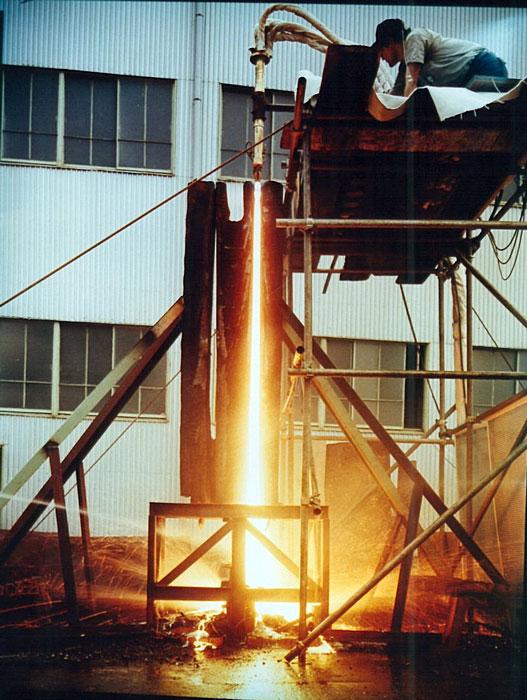
An oxyfuel cutting process cuts a workpiece that’s more than 8 feet deep. The cut edge isn’t pretty, of course. All the same, the exothermic reaction that the oxyfuel flame induces can carry cutting energy all the way through the workpiece.
For this reason, dry downdraft tables usually are the cutting tables of choice, but they often need to be altered for these extreme applications. Most machines designed to cut material that’s 6 in. or thicker would have blowers mounted into the saddle of the gantry. When sensors detect that the cutting environment has reached a certain temperature, the blower is activated. The blower forces the air to flow across the bottom of the table and exit out the opposite side, distributing heat away from the cutting process.
The preheat time is the most heat-intensive, simply because the torch isn’t moving. A series of six torches sits a long time to preheat such extreme material to kindling temperature.
The problem gets worse when you’re piercing. A pierce can put on quite the fireworks show, especially on a machine with multiple torches. It’s prime fodder for industrial photographers, but for operators and cutting department supervisors, it’s a nuisance at best and a serious safety hazard at worst. To account for the flying sparks, the machine structure, controls, and gas apparatus all need appropriate protection.
Another “hot point” during the cutting cycle happens after the torch makes a complete profile cut. Heat has already been concentrated at the cut start; the torch travels around the cut path and then returns to the original point, which has started to cool. When the torch returns, that point becomes so hot that it forces the workpiece to shift slightly, altering the cut path.
To prevent the work from shifting, operators program what’s known as a locking lead-in. Instead of leading in on a straight line, the torch follows an angular, almost puzzle-piece-like path. This lead-in essentially “locks” the cut part in place as the torch returns to its point of origin.
Starting the Cut
An oxyfuel operation theoretically can pierce through 8-, 10-, and 12-in. material, and even thicker. Machines even can be designed to handle the extreme heat such piercing produces. But quite often it just isn’t practical to do so; the combined preheat and piercing times are just too long.
Edge starting often makes the most sense; you can minimize the preheat necessary by heating the starting point manually with a rosebud torch before initiating the cutting cycle.
If edge starting isn’t practical or economical, you have several other options, both of which technically create a kind of “edge start” in the middle of the plate. The simplest method involves just making a pierce hole with a mag drill. But drilling takes time, too, and can become an arduous task in extremely thick material. An 8-in.-thick hole doesn’t always drill easily.
Another option is oxygen lancing. This usually is a two-person job. One person takes a rosebud tip and heats the pierce point on the plate until it’s cherry hot. Another person then grabs a steel pipe about 5 or 6 ft. long with an oxygen valve and hose at the end of it. He turns the oxygen on, which starts an exothermic reaction that blows a hole through the plate. The hole isn’t pretty, but the method can produce a quick pierce in certain circumstances, such as when a part on the nest has a large interior cutout.
Handling Considerations
Lean manufacturing gurus will tell you that to optimize material flow, you want to move material as few times as possible. Have it “done in one,” the saying goes. And in many cases, this is true, especially when a workpiece spends more of its time sitting between operations. The value-added time (this includes the actual cutting) is a small part of the whole process.
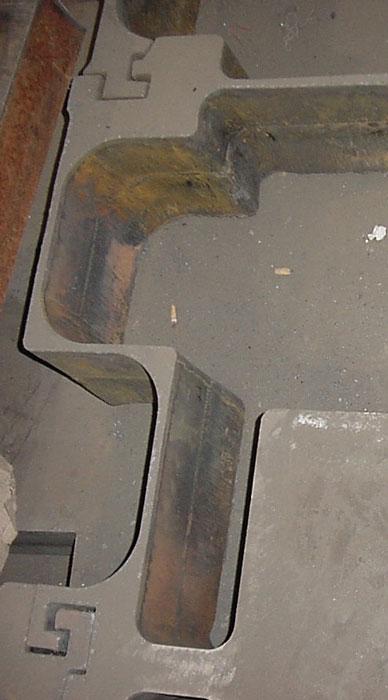
The locking lead-ins—shown by the “puzzle piece”-type cuts on the top and bottom left—prevent the workpiece from shifting due the effects of heat during the cutting cycle.
In extremely heavy plate fabrication, cutting—that is, when the torch is moving across the plate—remains a small portion of the overall process, but the preheating and piercing can take a lot of time. It takes so much time that often it makes more sense to move these massive workpieces to an oven, heat them, and then move them to the cutting table. Heating a thick plate of carbon steel—not red hot, but to a temperature that’s far too hot to touch—can decrease preheating, piercing, and cutting time significantly.
Operator Knowledge
Experienced oxyfuel cutting machine operators know the intricacies of the process, quite often without looking at the gas gauges. They’ve watched the preheat and cutting cycle thousands of times; the preheat flame of mixed oxygen and fuel gas brings the material to kindling temperature and performs piercing or edge-starting, and then the central oxygen jet takes over to propagate the exothermic reaction taking place in the cut.
Operators know to set the cutting oxygen just right; too low a flow can leave slag in the cut, and too high can produce a poor cut finish. They don’t necessarily need to refer to the cutting parameter charts, which specify the minimum amount of preheat fuel gas flow that can achieve the best cut quality and maximum cutting speed in a specified material thickness.
They have a feel for the process. They observe the flame, the blue-white color of a good neutral flame and the sputtering sound it makes when fired up through a large tip (for thick cutting). If they see sputtering or any irregularity in the plume below the surface, something’s amiss. They know that the leading edge of the oxygen jet is where that exothermic reaction between oxygen and iron is taking place, and if that oxygen jet is unstable, troubles can arise—like a gouge along the edge if the flame is moving too slowly.
Gas settings and cutting parameters vary with the application. In years past operators spent their days adjusting gas flows at the panel based on the thickness and tip size. Today, however, automatic gas consoles make the necessary adjustments, all based on material thickness and the tip size in use. All gas pressures are set automatically. The technology has become ever more critical, especially as old-school oxyfuel cutting machine operators reach retirement age.
At Home in Thick Plate
Preheating and piercing through thick plate can be a subtle art, but once the exothermic reaction starts, the oxyfuel flame is doing what it does best: cutting a vertical kerf with no top rounding. In fact, it can be much more difficult to achieve a quality cut in thinner material, especially less than 3/16 in. thick—material that’s much better suited for plasma, waterjet, or other cutting processes.
Regardless, even when cutting thick plate, oxyfuel cutting is not a fool-proof process. Machines need to be designed to handle heavy plate and positioned on the floor so that cranes can move the material into position. And the flame needs to move at the right speed and have the proper gas flow to achieve a good cut.
But when cutting is finished, and a large magnetic crane moves in and lifts an 8-in.-thick workpiece cleanly from the nest, it’s a sight to see. No wonder oxyfuel cutting remains the process of choice for processing extreme material thicknesses.
Tim Joslin is product manager and Ron Krasnek is marketing and export manager at Koike Aronson Inc., 635 West Main St., Arcade, NY 14009, 800-252-5232, www.koike.com. Photos courtesy of Koike Aronson.
About the Authors
Related Companies
subscribe now

The Fabricator is North America's leading magazine for the metal forming and fabricating industry. The magazine delivers the news, technical articles, and case histories that enable fabricators to do their jobs more efficiently. The Fabricator has served the industry since 1970.
start your free subscription- Stay connected from anywhere

Easily access valuable industry resources now with full access to the digital edition of The Fabricator.

Easily access valuable industry resources now with full access to the digital edition of The Welder.

Easily access valuable industry resources now with full access to the digital edition of The Tube and Pipe Journal.
- Podcasting
- Podcast:
- The Fabricator Podcast
- Published:
- 04/16/2024
- Running Time:
- 63:29
In this episode of The Fabricator Podcast, Caleb Chamberlain, co-founder and CEO of OSH Cut, discusses his company’s...
- Trending Articles
AI, machine learning, and the future of metal fabrication

Employee ownership: The best way to ensure engagement

Steel industry reacts to Nucor’s new weekly published HRC price

Dynamic Metal blossoms with each passing year

Metal fabrication management: A guide for new supervisors

- Industry Events
16th Annual Safety Conference
- April 30 - May 1, 2024
- Elgin,
Pipe and Tube Conference
- May 21 - 22, 2024
- Omaha, NE
World-Class Roll Forming Workshop
- June 5 - 6, 2024
- Louisville, KY
Advanced Laser Application Workshop
- June 25 - 27, 2024
- Novi, MI

























